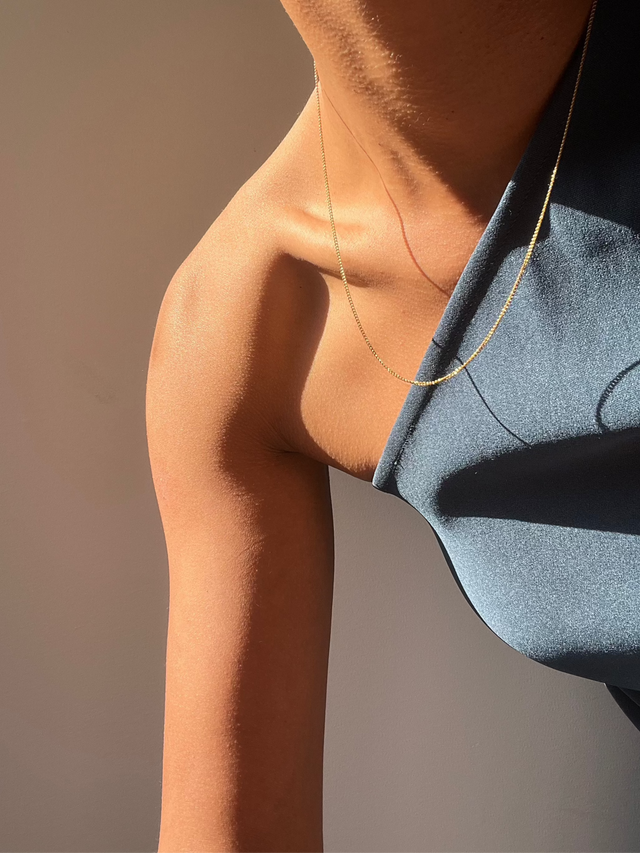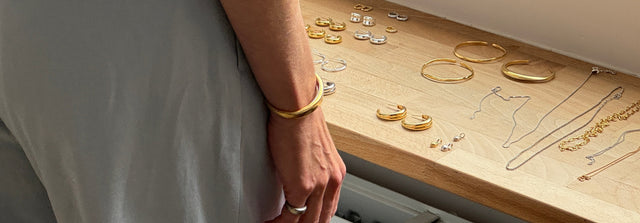Written by Saulė Petreikytė
When it comes to investing in timeless jewelry, whether that is a gold ring, or necklaces and bracelets, the most common question we receive is: what is the difference between 14k and 18k gold? To the naked eye, it might seem like the same thing, just one is cheaper, so I guess I’ll buy that one? In reality, there are a few key differences that affects durability, appearance, sensitivities, and, of course, price. Thus, understanding the nuances between 14k and 18k gold is crucial to make the best decision about a piece of jewelry that will stay with you for a lifetime (if you are lucky, it will stay with your generation for more than a lifetime).
What does the “k” mean?
K refers to Karat, which is a unit that measure gold purity in a piece of gold jewelry. That is not to be mixed up with Carat, which is a unit for measuring the weight of gemstones, such as diamonds. Back on track, 24 karats mean pure, 100% gold. No matter how “cool” it sounds to have a pure gold jewelry, it is inconvenient for everyday use as it is too soft. A 24k gold ring or bracelet would bend easily, scratch quickly, and lose shape over time. So, that is where other “ingredients” come in to make it more durable, such as copper or silver. Thus, 14k or 18k is much better suited (and trust me, it doesn’t diminish the fact that you are wearing gold, even if it is less pure).
But how do I count how much pure gold is in my gold jewelry? Don’t worry, no need for high school level math, but here is a little math problem. If 24 karat gold jewelry is 100% gold, then how much is 18/24 karat? Don’t go running to grab your calculator, it’s 75%! So, then what about 14k? Okay, I’ll tell you this one as well, it’s 58.3%. Now you can see the main difference, and that affects everything else – durability, appearance, price of your gold earrings, hoops, pendants etc.
Durability: 14k for the “Oh I don’t take my jewelry off, ever”
If you’ve been paying attention, I previously said that when it comes to pure gold being too soft, other metals get mixed in and the gold jewelry becomes harder (better, faster, stronger, sorry, daft punk came on the radio). When it comes to your favourite gold hoops and they need to withstand daily wear and tear, 14k is usually the better choice for you. Because of other metals, like silver, it is harder (better, faster, stronger, SORRY, sorry, turning the radio off), it is more resistant to scratches, or even bending, if the gold hoops are on the thinner side. Also, a 14k gold ring made from recycled materials is not only durable but also better for the planet. Thus, if you have an active lifestyle and you wish to preserve your gold cuff bracelet, aim for 14k.
Appearance: 18k if you aim to temporarily blind people with that rich gold colour
Whilst 14k is harder (yep, no more), 18k gold has the upper hand when it comes to appearance. Because of what percentage of gold in it? Yes, 75%! Because of 75% of gold in the 18k gold jewelry, such gold hoops, necklaces, bracelets have a richer, more vibrant yellow colour. Not only does 18k gold looks, but also feels more high-end, premium, and especially it stands out in comparison to cheaper, fast-fashion jewelry that turns your fingers green (yikes). Thus, if the aim for your sustainable jewelry is to have that classic, rich gold cue, lean towards 18k.
Price: 14k bites less when it comes to purchasing
As we have already learned (I hope), 14k has a lower gold content, thus it is more affordable than 18k gold jewelry. It doesn’t mean that it is significantly worse than 18k. It is elegant, timeless, but a bit more budget friendly. Thus, 14k offers a good balance between price and quality. However, if the occasion for which you are purchasing a gold ring or any other sustainable jewelry is more sentimental, opt for 18k gold. People tend to prefer the prestige and value of 18k gold for engagement rings and/or wedding bands.
Sensitivities: 18k gold is less allergizing
Due to 18k having fever alloy metals, 25% compared to 14k gold which has 41.7%, your 18k golden earrings are less likely to cause any skin irritations. If you happen to be sensitive to metals, 18k is a safer choice for items like gold earrings and gold rings that sit close and constantly to the skin. Having said that, some 14k gold jewelry are alloyed with hypoallergenic metals, so always check the composition of the piece to be certain that apart from being timeless, it won’t be annoying.
You already bought it! Wait, how do I take care of it?
Don’t stress, I got you. Proper care ensures that your pieces do stay with you for a lifetime, thus let’s look at how to take care of your 14k and 18k gold jewelry.
Cleaning: use warm water, if need be, a few drops of mild soap and a soft brittle brush to lightly clean your gold rings, earrings, necklaces and bracelets. Avoid harsh chemicals or say bye bye to that shine.
Storage: if you are not wearing your gold hoops or any other piece (not sure why you would take it off, but sure), then store it in individual soft pouches to avoid scratching, especially if you are traveling.
Polishing: occasionally polish your gold jewelry with a polishing cloth to maintain that beautiful shine.
Wear considerations: remove your 14k and 18k gold jewelry when swimming in salty waters or chlorine disinfected pools, as well as when doing household chores that include chemicals, which could damage your gold jewelry. Consider also taking off your jewelry during exercising, as it would not only protect your gold jewelry from scratches, but you are less likely to injure yourself (just don’t forget to put it on later!)
Since I already got your attention, let me answer some FAQ
Q: Does 18k gold tarnish?
A: 18k gold is less likely to tarnish because of its high gold content. Remember? 75%! It may, however, get dull overtime, but lightly polishing it will bring back the shine.
Q: Which gold is better for hot or humid climates, 14k or 18k?
A: 14k gold tends to perform better in hot or humid environments due to its stronger alloy composition, making it less prone to scratching or bending.
Q: How can I tell if a gold jewelry is 14k or 18k?
A: Look for a hallmark or stamp on the inside of the jewelry. For 14k gold, common marks are “14k” or “585”. For 18k gold, common marks are “18k” or “750”.
Q: Is there a noticeable weight difference between 14k and 18k gold jewelry?
A: Yes, 18k gold is denser due to its higher gold content, so a similar ring or bracelet in 18k will feel slightly heavier than 14k.
Final Thoughts: 14k vs 18k Gold – which one suits you best?
Aim for 14k gold jewelry if you want promised durability, great balance of quality and price, and you wish to never take your jewelry off. Works great for hoop earrings or gold rings.
Aim for 18k gold jewelry if you want high-end, prestige, rich golden hue, as well as a fewer likelihood of being allergized. Perfect for a gold ring with stone or a gemstone necklace.
In the end, the best choice for you depends on how active your lifestyle is, if you enjoy sleeping with all of your rings on, what is your budget for this timeless investment, if you have any preferences for the appearance, or happen to have allergies to metals. Whether you're eyeing a gold cuff bracelet, shopping for a sustainable jewelry option, or selecting the perfect gemstone necklace which you will treasure for a lifetime, understanding the difference between 14k and 18k gold helps you buy with confidence.
Explore our collection of 14k and 18k gold jewelry now and find the piece that fits your story.
Find similar articles:
14k earring 14k hoops 14k jewelry 14k ring 18k earrings 18k hoops 18k jewelry 18k rings gold plated earrings jewelryMentioned in this article
More stories




